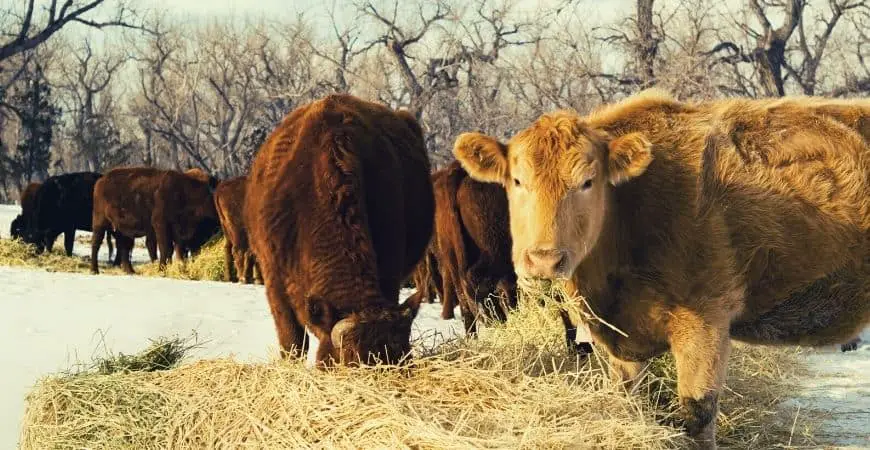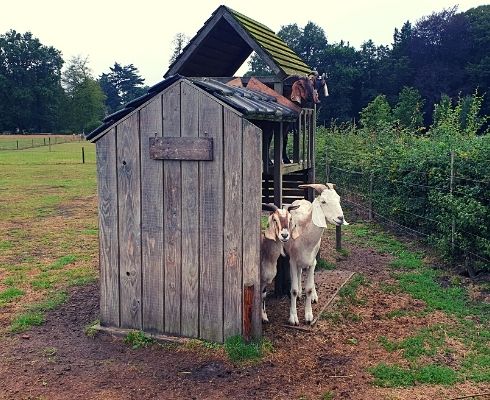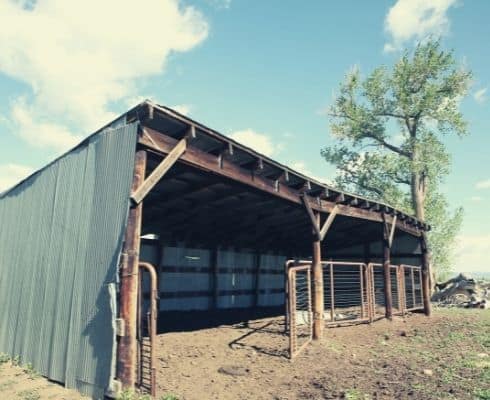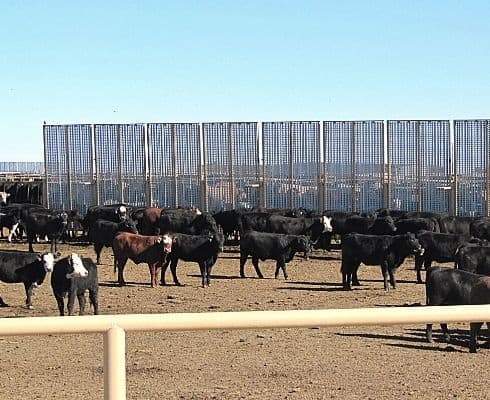It's that time of year again: Autumn and colder weather are coming. The temperatures are dipping below freezing, and the leaves on the trees have begun to change color. Do you know what this means for your dairy farm animals? They need more care than ever!
Caring for dairy farm animals during cold weather means keeping them warm and dry, sheltered from extreme temperatures, with plenty of nutritional food available. It also involves protecting them from winter viruses or chapped skin and treating them if need be.
Keeping all your dairy animals—cows, goats, and sheep—cared for properly in the colder months is vital for their health and productivity. We've compiled a list of baaa-sic tips to help you keep your stock happy and healthy during these chilly months so they can continue producing milk all winter long.
Provide Effective Shelter

A warm, dry shelter actually helps all the other concerns fall into place. An animal that is kept comfortably warm will tend to eat better, drink plenty, and not fall prey to the unfortunate winter tendencies of getting sick or suffering from chapped udders or hoof issues.
Animals are born with the natural ability to withstand a certain level of cold or heat. They put on an extra thick coat of winter fur that works to keep their bodies warm in the colder times of the year. What takes extra effort is sheltering your dairy animals from wind and excess moisture because:
With that being said, it is a good practice to provide extra shelter so your animals don't have to endure cold or inclement weather for too long. It's not healthy for them to stay too warm, even though we humans often think "the warmer, the better," so you may have to work a little to find the right balance between warmth and overheating.
Do Dairy Farm Animals Need Heated Shelter?
The need for a heated shelter really depends on the winter climate and how extreme the temperatures get. In southern climates, where winters tend to be milder, there is generally no need to provide a heated shelter for adult animals.
As long as dairy animals have access to dry bedding and can get out of the wind, they will manage just fine.
When they do come into the barn, the herd typically generates enough body heat to not need additional heaters.
For farmers with only one or two cows who don't generate a lot of body heat together, a barn heater can add just a little bit of warmth on the coldest days and nights.
Adult sheep and goats, on the other hand, do not need a heated shelter. Nature provides them with thick coats of fur that will insulate them well as long as they stay dry and are sheltered from the wind.
Best Forms of Shelter for Dairy Farm Animals

Full-size Dairy Barn
A full-size dairy barn is always an option for the very coldest of locations or days.

Covered Roof Shed
A small, covered roof shed out in the pasture gives animals someplace to get out of the rain and wind.

Three-sided Shed
Use a three-sided shed to provide shelter from the wind but with the benefit of one open side for ventilation.

Source: Agromatic
Barn Curtains
Barn curtains can be installed on the sides of a covered, open-air structure. These can be raised during the summer months to allow fresh air in but lowered during the winter to withstand blustery, cold winds.

Source: Daniels Manufacturing
Set up Windbreaks
Set up windbreaks around the pastures or other fenced areas based on the directions of the winter winds. Consider planting a row of evergreen trees, constructing a wind fence (portable or permanent), parking an old truck in the pasture, or stacking hay bales to provide a place for animals to get out of the wind.
Some farmers advocate keeping their animal barns heated with electric heaters or wood stoves to maintain a healthy environment for their cows, goats, and sheep during the winter months. If you choose to use heaters of any kind in your barn, consider these cautions:
Individual animals can also be covered with electric blankets or exposed to a heat lamp. Pregnant animals or those who've just given birth, as well as their newborns, will benefit from this personalized treatment.
Shelter for Cows
The ideal climate for cows is between 40° and 50°. However, once temperatures drop below that 40° point, it's time for you to step in and adjust the environment to keep the milk flowing.
Cows have an internal body temperature of 101.5, so putting a bunch of cows together is like turning on a heater. Massing a herd indoors will raise the temperature of the space significantly, making this an effective way to keep cattle warm.
Young cows are more vulnerable to the cold than adult cows. With baby calves, you may need to take additional steps to ensure their warmth. Farmers often provide calves with a "puffy coat" to wear on the coldest days. These coats are typically wind- and water-resistant with an added layer of fill to bring extra warmth.
Shelter for Sheep and Goats
Sheep can withstand the cold fairly well because they have their very own wool coat. However, they still need shelter from the wind with a wind block or a three-sided shed. Ewes giving birth should be brought into the barn, and their newborn lambs dried off quickly to prevent hypothermia.
Goats need very little extra care since they are blessed with a thick coat of fur that helps them deal with cold temps. Still, plan to provide them a three-sided shelter with a southern-facing opening to give them somewhere to go out of the wind. In addition, newborns should be given warmer shelter to help keep their small bodies at the proper temperature.
Note: If you bring any dairy animal herd indoors, be sure that the space is well-ventilated. Poor ventilation will lead to a decline in air quality and a build-up of ammonia or respiration gases, which can lead to respiratory illnesses and overall poor health.
Offer Dry Bedding
Dry bedding for your dairy animals serves as insulation against the cold ground. It helps reduce the energy the animals have to expend to stay warm. Bedding also helps keep animals clean since some (cows in particular) choose to lie in their own manure for warmth.
Keeping dairy animals dry is a key component of maintaining their good health, which in turn means continuing milk production through the winter.
Bedding for Cows
Lactating cows are susceptible to frostbite on their teats if they lie down on an unprotected, cold surface. Therefore, providing a warm, dry place to lie down is critical to preventing this painful and damaging condition.
For cows, you can use straw or hay mixed with sawdust. It provides good insulation that will help retain heat in their bodies when temps dip down low. Another option is using corn stover or other leftover harvest material.
Also Read: Cow Mats and their Benefits for Dairy Cows
Bedding for Goats and Sheep
You can also spread straw or hay on the ground for goats and sheep or use it stacked as bales. Wool blankets and wood chips or shavings spread on the floor will also see many uses by sheep or goats.
Monitor Nutritional Needs
Colder temperatures signal dairy animals that it's time to put on an extra thick layer of fur and hair for added warmth. To do this, these animals require a nutritious diet of well-balanced feed.
Adjusting their food intake by offering more opportunities to eat high-quality feed will provide the animals the extra energy it takes to put on fur and to stay warm in the cold winter months.
If cows, sheep, or goats are skinny at the onset of winter, you'll need to monitor them more closely since they don't have the extra fat insulating against cold.
Lactation is an energy drain on dairy animals. The cold only increases this. In fact, the American Dairymen Association website refers to a USDA study that showed lactating cows need 50% more maintenance energy when temps drop below freezing.
With this increased food intake, it's important not to overfeed your dairy animals and cause digestive issues. A dairy nutritionist can help farmers maintain the right mix of nutrition in their feed to promote energy production without compromising digestive health.
Nutritional Needs for Cows
The Country Dairy says that keeping a cow's rumen (one of its four stomachs) full "fires up" its metabolism, comparable to throwing wood on a fire to keep it burning.
To ensure optimum feeding, cows need to have the chance to visit the feed trough at least 21-22 hours of each day. Particularly for cows that produce a lot of milk, this almost continual access to food helps keep that fresh, quality milk flowing.
Cows don't like their feed wet, so make sure it is in a dry location. Install a roof over an outdoor feed station if needed.
Nutritional Needs for Goats and Sheep
The dietary needs of goats and sheep change during the winter months for the same reason as cattle: it takes more energy to stay warm and increased food intake supplies that extra energy. Plenty of hay is the answer.
Goats should also be given roughage through alfalfa, mixed hay, or grass. According to Michigan State Extension, feeding goats alfalfa hay is a sure way to get them extra energy and protein. The MSU Extension also recommends feeding lactating sheep five pounds of high-quality hay accompanied by two pounds of a crude protein grain mix every day.
Sheep (and goats) will benefit from the added calories supplied in cracked corn, oats, sweet feed, or pelleted feed, which contributes to better overall health.
Offer Plenty of Fresh Water
You might think dairy animals can get by with less water since it's not hot. That is not the case, however. Access to fresh, clean water is absolutely necessary for dairy animals during cold weather. In fact, dairy cows won't make milk if they don't drink water.
Providing cows, goats, and sheep with plenty of fresh water during cold weather is critical to the production of milk, and it encourages better milk production overall.
The Wisconsin State Farmer says that cows can drink a bathtub-sized amount of water every day. Multiply that by the size of your herd, and you've got a lot of clean water to supply! Making sure quantities like this are available when the temperatures drop below freezing, even below 0°, requires a lot of planning and hard work.
So, how much water are we talking about, really?
Dairy Animal | Gallons of Water Needed per Day |
|---|---|
Cows | 7 - 12 or more |
Sheep | 1 - 4 |
Goat | 1 - 4 |
(Source: MSU)
Sheep and goats might not drink quite as much as cows, but they still need access to fresh, drinkable water throughout the day and night.
When temps drop below freezing, it takes extra effort to ensure your animals can get to water that is unfrozen and not too cold to drink. Cows, for instance, prefer water that is 40° to 65° in temperature.
The solutions to making sure your animals have the water they need range from inexpensive yet labor- and time-intensive ice-clearing throughout the day to costly automatic watering systems that offer water in the right quantity and temps no matter what the season. Consider these options:
Guard Against Winter Illnesses
Winter can be a time of sickness for dairy animals. The intense cold coupled with lowered immunity and more congregation with other animals in closed spaces can lead to increased bouts of illnesses. Animals with underlying health conditions and also the very young are especially susceptible.
Staying outside in the cold can make dairy animals susceptible to respiratory infections. They also may not warm up enough and stay chilled due to the lack of insulation under their skin, especially in the udder area.
Preventing all sickness is not really possible, but you can watch your livestock closely for signs of the most common illnesses and deal with them as soon as they're spotted.
When medications are prescribed for an illness, be sure to store them properly. For example, meds that are sensitive to cold should be stored in a warm location since they can freeze in the bottle or syringe and become ineffective.
Pneumonia and Respiratory Diseases
Cold weather can cause dairy animals to become susceptible to pneumonia, which is why dry, winter bedding is essential. Grazing near cold streams or rivers and being exposed to cold temperatures for too long can bring on various types of pneumonia.
While being outside too long can cause problems, so can being indoors. Housing animals in poorly ventilated spaces like barns without any fresh air movement may result in respiratory diseases that, left untreated, can lead to serious health complications and even death.
To prevent pneumonia, make sure the animal is well rested and that their living space stays warm. It's also important to keep them away from any drafts. If you see condensation on the walls or ceiling of your animal's shelter, it's not ventilated well enough. You should take steps to get more air flowing through the space.
Signs of pneumonia and other respiratory illnesses include:
To nip these breathing and lung problems in the bud before they become more serious, you should contact your veterinarian so that medications like antibiotics can be prescribed.
Poor Udder Health and Care
We've all experienced dry, chapped skin during the winter months. For us, it's inconvenient and sometimes a little painful. This chapping can occur on the udder and teats for dairy animals, leading to cracked skin that is very painful to the animal.
Udder problems occur when the udder and teats are not kept dry. Lying on wet or frozen ground, staying wet after milking, or leaking milk can cause issues with a cow's udder. Also, frostbitten teats are a real danger with lower temperatures and the effects of wind.
Cracked skin can allow mastitis to enter the udder, which can lead to serious damage and death of udder tissue in severe cases. Even when mastitis is less severe, it can affect milk production because it is a painful condition that causes a cow to avoid milking, and by extension, it makes less milk.
Udder ailments should be addressed promptly by:
Lice
Lice and other parasites in goats are a common occurrence during the winter months. While not dangerous, per se, it is an irritating condition for the goat. If you allow any parasitic infestation to go untreated, it can lead to anemia or a decline in the health of the goat's hide or skin. Treatment by a vet should take care of this annoying problem.
Winter Dysentery
Cows can be inflicted with winter dysentery, an unpleasant illness that causes gag-inducing black-green diarrhea. It's not often fatal, but winter dysentery can significantly affect milk production.
Avoid subjecting your livestock to this winter illness by keeping their bedding fresh and clean and moving their feed stations frequently.
Foot Issues
Off the Grid News shares that cows (and other dairy animals) that are kept outdoors have fewer foot problems than those housed on concrete floors. So, one way to lower the incidences of foot issues is to allow your herd to stay outside if at all possible, depending on the weather.
Animals kept in the pasture are in direct contact with wet and frozen ground. And since they are at pasture, it can be more difficult for the farmer to monitor foot health. It will take more vigilance to track and treat any foot problems that arise.
If you're concerned about foot care, keep an eye out for these conditions:
Keep the Dairy Farm Animals Moving
Get them moving! Try to keep your dairy animals on pasture when the weather allows. This way, they can graze and groom themselves, which helps with their mental health as well. You'll need to watch outdoor temperatures so that you're prepared to bring animals into a shelter if the weather turns extreme.
Recent practices have not seen much winter grazing of dairy animals. Large-scale dairy operations for ruminant animals (cows, goats, and sheep) rarely pasture-graze their animals, ever. Smaller dairy farms have typically chosen to bring animals in during the winter.
Extreme weather permitting, it is possible to let dairy animals forage and graze outside during the cold months. One benefit includes lowering the costs of feeding your stock because less hay is needed since animals are foraging for grass.
If your cows, sheep, and goats are moving around the farm, here are a few things you can do to ensure their safety and well-being:
Tips for Caring for Newborn Dairy Animals in Cold Weather
Newborn dairy animals will require additional care during the cold winter months:
As with older animals, proper ventilation and air quality—along with the proper feed and plenty of water—will ensure that your youngest stock enjoys good health and development.
Final Thoughts
The winter months can be tough for animals and challenging for those who care for them. Dairy cows, goats, and sheep all need extra care to prepare them for the cold season, and that extra care requires a lot of work from the farmer.
The above cold weather care guide for dairy animals should help you stay on top of your livestock needs in these winter months! Being proactive and vigilant in planning for the cold weather will ensure that your dairy animals continue producing high-quality milk and bringing in plenty of income for you all winter long.
